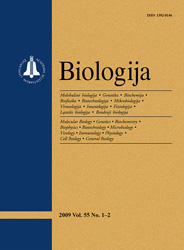Biologija / Biology
WHAT?
 ISSN 1392-0146 ISSN 2029-0578 (online) |
2006 m. Nr. 1 Kluyveromyces lactis gene KlBIM1 in high copy state
suppresses heterologous protein secretion
The effect of nitrogen fertilizers on the physiological indices of winter wheat (Triticum aestivum L. variety ‘Ada’) was investigated in experimental fields of the Lithuanian University of Agriculture in 2005–2006. The rates of fertilizers during plant vegetation were as follows: N90, N150 and N180. In sowing time, wheat was fertilized with N30P80K120. In tillering stage, plants were fed with calcium-ammonium nitrate N60 and N80. In booting stage, they were fertilized through leaves with carbamate solution N30 and N40. Wheat organogenesis stage, photosynthetic pigment and carbohydrate contents were determined. According to our results, plants respond to nitrogen supply differently during separate phenological phases. Supplementary fertilization accelerated plant development only at lower applied concentrations (N150) and developmental differences showed up only in booting stage. The best development was related with a high chlorophyll a / b ratio and a low carbohydrate content. Total photosynthetic pigment contents increased with plant age and were higher at higher fertilization rates. Chlorophyll a, b and carotenoid biosynthThe aim of this work was to investigate the genes that under over-expression in the yeast Kluyveromyces lactis decrease the yield of secretory proteins. The MD2/1-9 mutant strain with an enhanced ability to secrete different proteins was used. The genes suppressing the protein secretion process were detected by using the -amylase gene. The gene KlBIM1 was found to suppress mutation of the MD2/1-9 mutant strain in yeast K. lactis. To test the influence of the chromosomas gene on protein secretion, the BIM1 gene was disrupted in both yeast K. lactis and S. cerevisae, and the influence of disruption on the protein secretion process was evaluated. The disruption of the gene KlBIM1 had no influence on the protein secretion process in K. lactis, however, disruption of the BIM1 gene in S. cerevisiae elevated protein secretion by approximately 24%. Our experiment has shown that K. lactis strain lacking the gene KlBIM1 is not suitable for elevated heterologous protein secretion. The K. lactis mutant strain MD2/1-9 was transformed by the S. cerevisiae gene BIM1 in order to evaluate the influence of this gene in a high-copy state to the -amylase secretion process. The S. cerevisiae gene BIM1 in a high-copy-number state significantly decreased secretion of -amylase in K. lactis MD2/1-9. This fact suggests that the homology between the gene KlBIM1 in K. lactis and BIM1 in S. cerevisiae is rather high and the biological function of those genes in both yeasts is quite similar.esis showed similar responses to N fertilization. The increase in photosynthetic pigment contents coheres with a decreased fructose accumulation and an enhanced disugar (sucrose and maltose) synthesis intensity during wheat growth. The results confirm the potentiality to control wheat physiological indices by using different nitrogen fertilization designs.
Keywords: yeast, Kluyveromyces, secretion, heterologous proteins, KlBIM1 |
Issues:
2011 - Vol.57 No. 1, No. 2, No. 3 2010 - Vol.56 No. 1-4 2009 - Vol.55 No. 1-2, No. 3-4 2008 - Vol.54 No. 1, No. 2, No. 3, No. 4 2007 - Vol.53 No. 1, No. 2, No. 3, No. 4 2006 No. 1, No. 2, No. 3, No. 4 2005 No. 1, No. 2, No. 3, No. 4 2004 No. 1, No. 2, No. 3, No. 4 2003 No. 1, No. 2, No. 3, No. 4 2002 No. 1, No. 2, No. 3, No. 4 2001 No. 1, No. 2, No. 3, No. 4 |